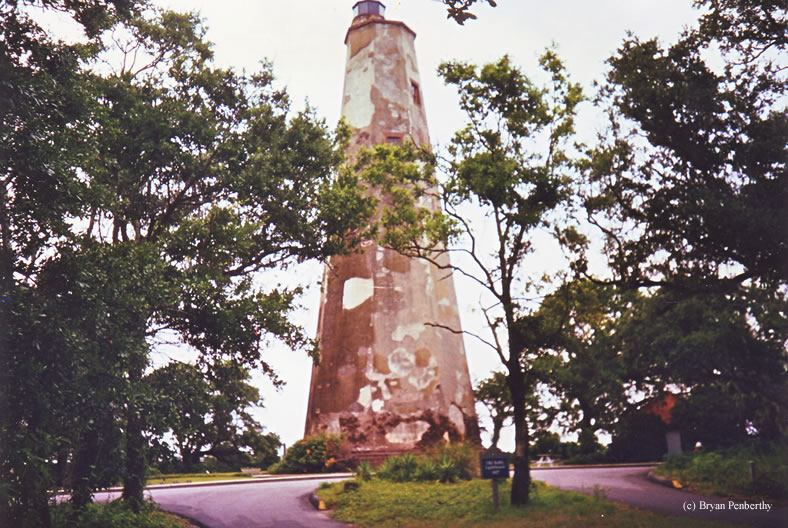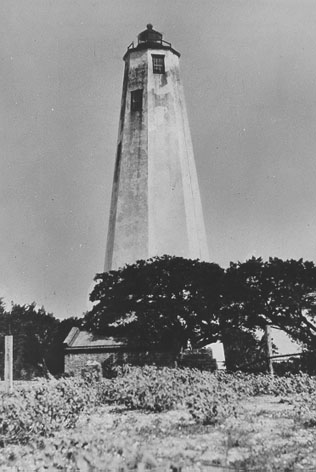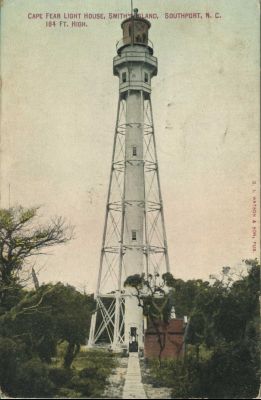Bald Head Island Lighthouse
Bald Head Island, North Carolina - 1817 (1789**)

History of the Bald Head Island Lighthouse
Posted/Updated by Bryan Penberthy on 2013-03-04.
As commercial activity flourished in North Carolina in the mid-1700s to the 1800s, Wilmington became one of the largest ports in the state. A hurricane struck the area on September 23, 1761 carving out a new inlet near the mouth of the Cape Fear River. This new inlet would shorten the travel time to the Port of Wilmington, and would become the preferred route of mariners.
In 1784, the General Assembly of North Carolina passed a law to establish rules for navigating the Cape Fear River. One of the things the law did was levy a tax of six pence per ton on incoming cargo to raise money for a lighthouse. The law stated that the lighthouse was to be built "at the extreme point of Bald-head or some other convenient place near the bar of said river, in order that vessels may be enabled thereby to avoid the great shoal called the Frying-Pan."
By 1789, the Colony of North Carolina had purchased a ten-acre site on the west side of Bald Head Island from Benjamin Smith, who would later become governor of North Carolina in 1810. The commissioners followed the law to the letter and constructed the lighthouse dangerously close to the river. They contracted with Thomas Withers for the delivery of 200,000 bricks, but due to several issues, they were never delivered.
 Bald Head Island Lighthouse (C.G.)
Bald Head Island Lighthouse (C.G.)
North Carolina joined the United States in November of 1789. The following year, the State of North Carolina ceded the ten-acre plot of land and the incomplete lighthouse to the federal government. Congress approved an act on April 2, 1792 appropriating $4,000 for completing the Bald Head Island lighthouse.
It appears that the $4,000 allocated in 1792 was not enough and additional appropriations would be necessary. An act of March 2, 1793 appropriated an additional $2,000 and an act of January 2, 1795 appropriated an amount "not exceeding four thousand dollars." A final payment of $1,359.14 was approved on March 2, 1797 bringing the total cost of the lighthouse to $11,359.14.
The United States Treasury, the department of the federal government in charge of lighthouses at the time, appointed contractor Abisha Woodward to complete the Bald Head Island Lighthouse. He would later go on to construct the New London Harbor and Falkner's Island Lighthouses in Connecticut.
The lighthouse was completed and ready for operations on December 5, 1794. It was first lighted on the night of December 23, 1794. A few years later, erosion threatened the lighthouse. By 1810, efforts were put forth to stop the erosion including construction of a jetty. In the end, it would not be enough as the beach underneath the lighthouse began to erode in 1813. It was ordered to be torn down for safety reasons.
Between 1813 and 1817, Congress had appropriated $16,000 for rebuilding the Bald Head Lighthouse. It would later become affectionately known as "Old Baldy."
The tower was completed in 1817 under budget and further inland to ensure its longevity. The ninety-foot octagonal brick tower was built by Daniel S. Way, who had constructed the first Point Judith Lighthouse in 1810. It is reported that some of the bricks included in this tower were reused from the original lighthouse.
The tower, built upon a stone foundation, was constructed to withstand the elements. At its base, the tower is thirty-six feet wide with five foot thick walls tapering to fourteen-and-a-half feet wide with two foot thick walls. The ground floor was also constructed of brick, but the stairs, other floors, and joists are Carolina yellow pine. It was topped off by an iron lantern from the foundry of R. Cochran, which was brought over from the original lighthouse.
Like most early lighthouses, the Bald Head Island Lighthouse used a series of lamps and reflectors as its illuminating apparatus. In the early 1850s, after a report of the superiority of Fresnel lens, they were widely adopted in the United States. Most likely, around that time, a fourth-order Fresnel lens was installed. It was replaced by a larger third-order Fresnel lens in 1855. A Jones fog bell was added the same year.
The lighthouse, due to its abbreviated nature, was ineffectual at aiding ships past the perilous Frying Pan Shoals. A request was made in 1851 by the Lighthouse Board to enhance the Bald Island Lighthouse. The recommendation was made to raise the tower an additional sixty-feet bringing the height to 150-feet, and to upgrade the lens to a first-order Fresnel. Rather than undertake the ambitious project, the Lighthouse Board placed the Frying Pan Shoals lightship offshore in 1854. It served the location until 1964, when it was replaced with a modern "Texas Tower" style lighthouse.
 Frying Pan Lightship and Frying Pan Tower.
Frying Pan Lightship and Frying Pan Tower.
A new inlet formed near the present day Fort Fisher Ferry landing. As this became the preferred route to the Cape Fear River, a new screw-pile style lighthouse was constructed in 1866 known as Federal Point. It was described as a two-story frame dwelling standing on a foundation of nine iron piles with a lantern on its roof.
During the Civil War, Confederate soldiers darkened both structures to prevent them from aiding Union troops. At the culmination of the war, only the Federal Point light was relighted.
A hurricane rolled through and deepened the new inlet channel of 1861. A seawall, called The Rocks, was constructed in 1881 by the Engineering Department to close the inlet. With the closing of the inlet, the Federal Point Lighthouse was no longer necessary. Old Baldy was needed again. It was relighted on January 1, 1880, the same day the Federal Point Lighthouse was discontinued. Later that year, the Federal Point Lighthouse burned down.
The Annual Report of the Lighthouse Board of 1879 had the following entries:
369. Cape Fear, on Bald Head, entrance to Cape Fear River, North Carolina - The closing of the New Inlet channel by the Engineer Department, rendered the light near that inlet, Federal Point, useless, and was discontinued. The one on Bald Head was relighted, and it, and small stake-light on the beach in front of it, serve as a guide through a 16 to 18 feet deep channel across the bar. As this light was discontinued several years ago many repairs to the tower were necessary before the station could be relighted, and much still remains to be done.
Cape Fear (Bald Head), near entrance to Cape Fear River, North Carolina, re-established, January 1, 1880.
A new two-story keeper's dwelling was constructed on site in 1883. Soon thereafter, erosion threatened the station. The Army Corps of Engineers constructed a 150-foot long jetty, and later extended it to 200-feet which successfully reversed the erosion. The keeper's dwelling was lost to fire many years later in 1931.
By 1889, the Lighthouse Board was recommending a first-order light on Bald Head Island due to the increased shoaling in the area. The board would echo the recommendation every year throughout the 1890s. Congress relented and passed an act on July 1, 1898 approving a first-order light. The Annual Report of the Lighthouse Board dated 1899 had the following entry:
Cape Fear, seacoast of North Carolina - An appropriation for a first-order light-house, to be built on the pitch of Cape Fear, Smith Island, North Carolina, having been made by the act approved July 1, 1898, and authority given to contract to an amount not exceeding $70,000, a survey was made in September, 1898, on Smith Island and a site of 20 acres was selected, with right of way, along which a tramway line was located, connecting the site with the Cape Fear River. A boring made indicated a good foundation for the tower. Legal measures are being taken to procure a title to the selected site.
Over the next several years, the work progressed along. By August 31, 1903, the first-order Fresnel lens of the new Cape Fear Lighthouse was illuminated and began flashing. At this time, Bald Head Island Lighthouse's fourth-order flashing light was changed to a fixed white light so that it was easily distinguished from the new Cape Fear Light. Three cottages were built near the new Cape Fear Lighthouse to serve as keeper's dwellings.
 Cape Fear Lighthouse courtesy Southport Times.
Cape Fear Lighthouse courtesy Southport Times.
When the Bald Head Island Lighthouse was put back into service in 1880, the third-order Fresnel lens was replaced with a fourth-order Fresnel lens making it a harbor beacon. It continued to serve this purpose until its deactivation in 1935. A radio beacon replaced the Fresnel lens in the lantern in 1941 until 1958. The lighthouse was sold to a private owner in 1963. At some point, the private owner sold the tower to the Carolina Cape Fear Corporation who turned it over to the Old Baldy Foundation in 1987; a group organized in 1985 to preserves the state's oldest lighthouse.
Over the years, the Old Baldy Foundation has performed many renovations, including plaster work on the tower, replacing the copper roof on the lantern room, and repairing the wooden stairs inside the tower. The tower was relighted as a private aid to navigation on April 2, 1988.
When originally completed, the brick tower was covered in a stucco finish, and then whitewashed to preserve it. Over the years, as the stucco has fallen off, it was patched with new stucco giving it a unique patch work look.
In 1997, the Old Baldy Foundation developed plans to recreate on of the three keepers' cottages that had once stood on site. By 2000, the cottage was built and provided office space for staff, a small gift shop, and houses the Smith Island Museum.
Reference:
- Lighthouses of the Carolinas - A Short History and Guide, Terrance Zepke, 1998.
- Annual Report of the Light House Board, U.S. Lighthouse Service, Various years.
- America's Atlantic Coast Lighthouses (6th edition), Jeremy D'Entremont, 2005.
- "The Original Bald Head Island Lighthouse," John Hairr, Lighthouse Digest, June 2001.
- "What is Bald Head Island?," Ben Steelman, myreporter.com, May 8, 2009.
- "A History of 'Old Baldy'" Gary, townofbaldheadisland.com, June 15, 2013.
Directions: To get Bald Head Island, or Smith Island as it was referred to many years ago, take Route 133 South from Wilmington (~32 miles) to Route 211 (North Howe Street). Make a left onto North Howe St. Continue up North Howe Street, then make a right onto West 9th Street. There will be signs. Follow West 9th Street to the Indigo Plantation. They run the ferry service to BHI. There is a fee for parking and as of June of 1997, there was a charge of $15.00 per person.
Access: Museum and tower open Tuesday-Saturday 10-4 and Sunday 11-4. Minimal cost for climbing the tower. More information available at www.oldbaldy.org
View more Bald Head Island Lighthouse picturesTower Height: 90.00'
Focal Plane: 109'
Active Aid to Navigation: Deactivated (1930)
*Latitude: 33.87350 N
*Longitude: -78.00030 W
See this lighthouse on Google Maps.
